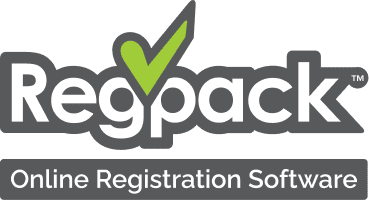Wait until your students sign up for your course before you start challenging them with difficult tasks and new ways of thinking.
Make the course registration process itself as simple and comfortable as possible for them.
That way, your conversion rates will remain high, and no excited potential customers will become drop-outs before they’ve even begun learning with you.
In this article, we’ll go over the five best ways to optimize your course registration process, reviewing techniques such as using embedded forms, offering group registration, streamlining payment, and more.
- Have Embedded Registration Forms
- Offer Group Registration
- Allow for Mobile Registration
- Make It Easy for the Applicants to Pay
- Send Automated Confirmation Emails
- Conclusion
Have Embedded Registration Forms
Make the registration process effortless for your potential customers by placing embedded, online registration forms on your website, especially on high-traffic pages.
With embedded forms, your customers can register for your courses from their computers and mobile devices. All they need is access to the internet.
For example, here’s an online form allowing visitors to register for a course called Killer Cold Emailing:

Source: Writing Revolt
Filling out a form like the one above is much easier than submitting the information by mail, or dropping the documents off in-person.
And customers value convenience. If something’s too complicated or takes too long, that might be just enough reason for them to procrastinate or put it off indefinitely.
Plus, when you use an embedded form, the entire transaction happens on your website.
The potential customer isn’t redirected to some unfamiliar page to fill out the form, an event that can scare them off, especially if it’s financial data they’re submitting.
To create embedded online registration forms, use an online form builder tool. Most registration software, including Regpack, comes with this easy-to-use feature:

Source: Regpack
With the drag-and-drop editor, you can create a form that includes the fields needed to capture vital student data.
You can put in fields like the student’s full name, phone number, email address, and even a payment form that offers multiple ways to pay, from card to ACH transfer.
Once the form is created, it’s easy to embed it in your website, social media posts, or other channels, thanks to the line of HTML code the form builder gives you:

Source: Regpack
In sum, embedded forms help you optimize your course registration process and improve conversion rates by enhancing the registration experience for your customers.
Offer Group Registration
Offering group registration means providing your potential students with the ability to register themselves and multiple other people for a particular course at the same time.
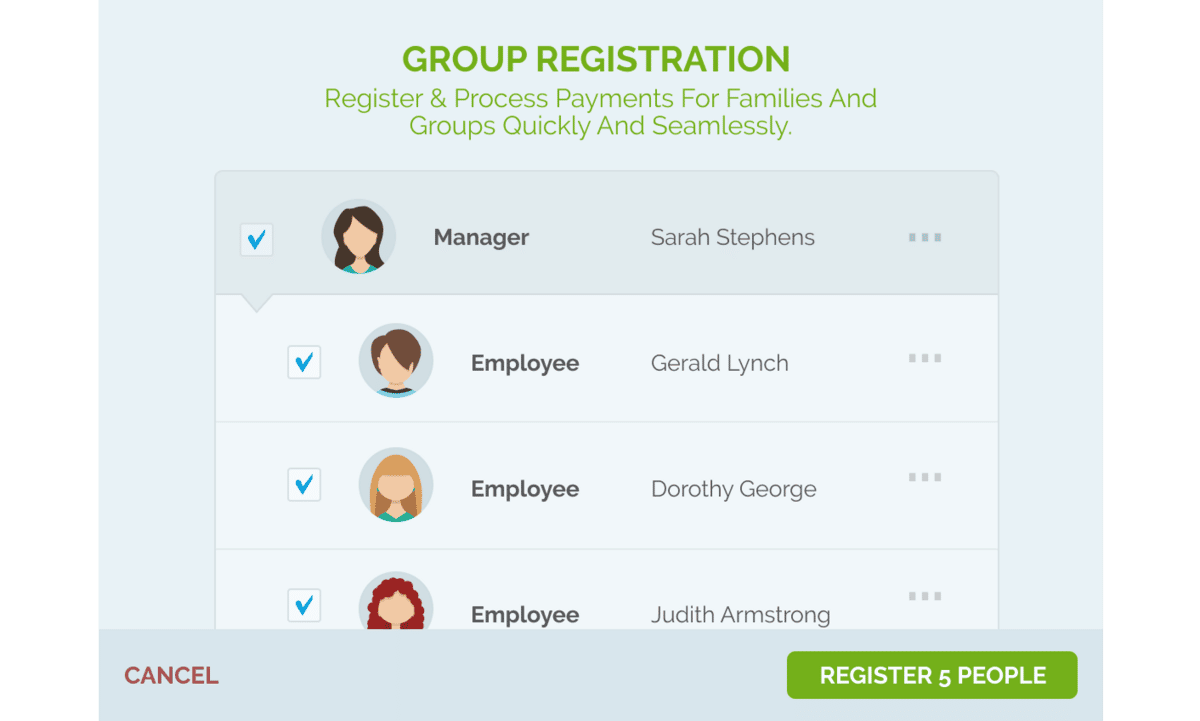
Source: Regpack
This is convenient when multiple applicants from the same organization need to be registered for the same course.
For example, if a manager wanted to sign their team up for a leadership course, they could do so through group registration.
When one group member can take charge, the others have the benefit of forgoing the registration process entirely, provided that the leader has their information.
This also gives customers the assurance that they’ll be in the same session or, if the class is in-person, the same seating area.
No one has to worry about the class filling up and having to choose a different time slot than their friends or colleagues.
Here’s an example of what group registration looks like for the lead applicant using an online registration form hosted by Regpack payment software.
First, they’re asked how many people they’re signing up for the wildlife course:

Source: Yellowstone Forever
If they select that they want two tickets, as we’ve done above, next they fill out two more pages of questions, one for each attendee.
For instance, here’s the first page, meant for registrant #1:
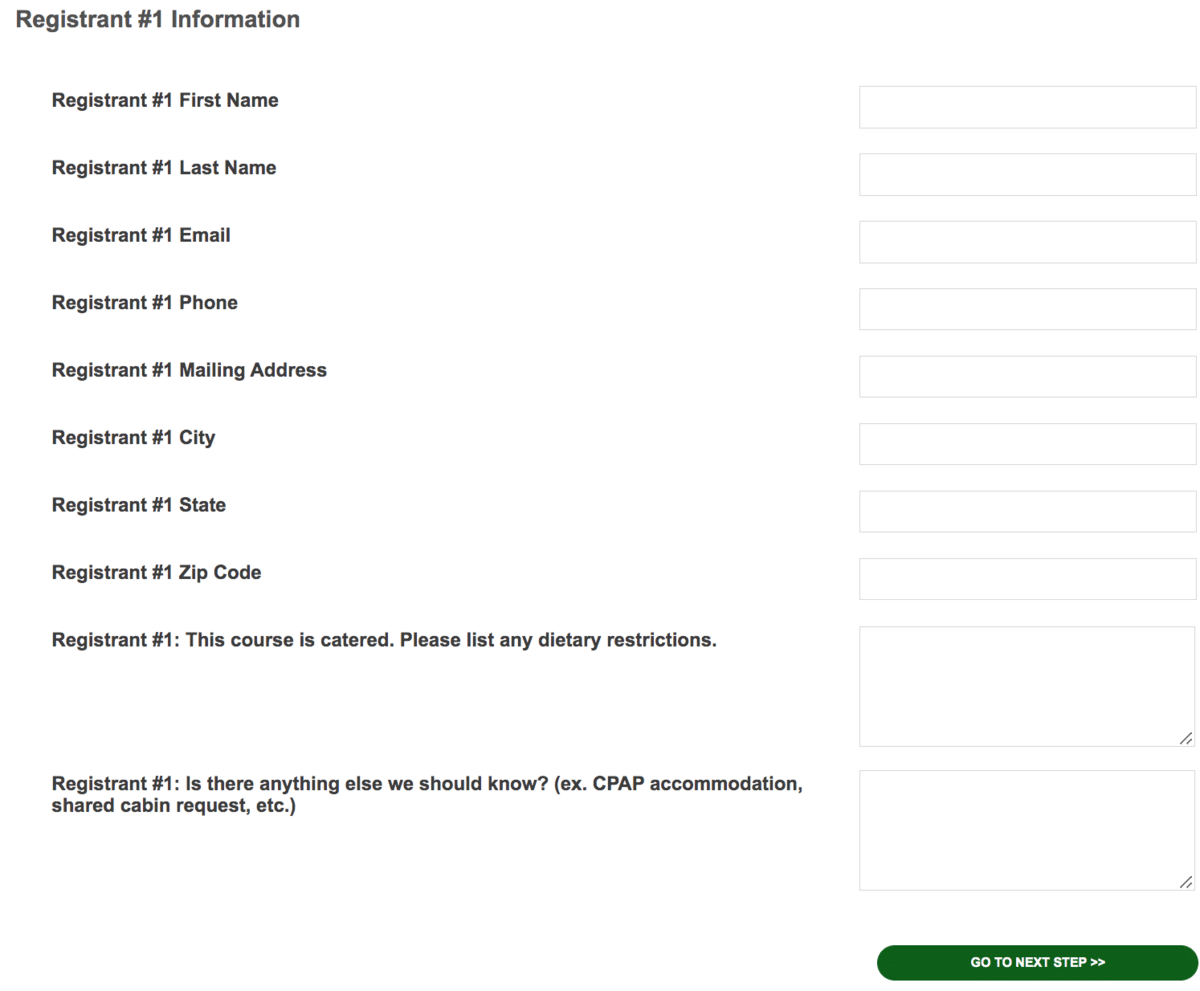
Source: Yellowstone Forever
The next page of the form has the exact same layout, but this time, it should be completed with the information for registrant #2.
Once the user has filled out the form, they then pay for the course.
In many cases, the other attendees will receive confirmation emails with any course information that they need.
Although it takes a bit longer for the individual to sign up their friends or family members, that’s okay because this person is probably the most motivated to attend anyway.
That’s often why they took the lead.
Plus, they’ve accepted the responsibility, so that’s another reason why a few extra fields to fill out won’t turn them away.
Offering group registration is another great way to make your course registration process more convenient for your potential students.
Allow for Mobile Registration
Everyone has a mobile phone these days, and many use it in place of a computer for doing product or service research.
It’s likely that many people are accessing your website through their smartphones. According to Zippia, around 62% of all web traffic comes from mobile devices.
Therefore, to further optimize your course registration process, it’s essential to give customers the ability to register for the course via their mobile devices.

Source: Formstack
If a potential student is researching your course on their mobile device, and wants to register, the last thing you want to do is interrupt their momentum by forcing them to go grab their computer to finish the process.
A poor mobile experience can also signal to the customer that your business doesn’t really know what it’s doing, causing them to second-guess your value.
Therefore, enabling online registration isn’t enough. You should use mobile-friendly registration forms that adapt to the student’s mobile device regardless of screen size.
You should also make an effort to ask for the most critical information in those forms, thus keeping them short. Any unnecessary fields should be eliminated.
Including a lot of questions and making the user scroll down endlessly can cause them to feel overwhelmed and give up.
Additionally, leverage drop-down lists to make the form appear and feel shorter, like in the example below.

Source: Medium
When you give customers a seamless experience accessing and filling out your course’s registration form through their mobile devices, you increase the form’s conversion rates and win more students.
Make It Easy for the Applicants to Pay
You can streamline the payment process for your applicants by enabling them to pay online through your website after filling out the course registration form.
An integrated payment processing software, like Regpack, allows you to create custom payment forms and embed them on your site with ease.
Then students can submit their payment information into these forms, and the payments will be processed safely, thanks to security measures like tokenization and encryption.
Here’s an example of such a payment form.

Source: Regpack
The form prompts customers to input the information needed for the payment type they’ve selected, and makes those required fields, so the form cannot be submitted unless all of the necessary information is present.
An online payments system will also alert the customer immediately if their payment has failed so that they can fix the mistake or try another payment method.
To further enhance the payment experience, also consider offering your customers various ways to pay for your course, from credit and debit cards to ACH transfers and e-wallets.
This enables your students to pay in whatever way they find most convenient, and it reduces the likelihood that a customer won’t be able to pay because you don’t offer their preferred method.
Here are the most popular online payment methods.

Source: Oberlo
If your business operates globally, it’s also a good idea to use an online payment provider that allows payments in multiple currencies.
That way, if someone buys an online course in Mexico, they’ll be able to pay in pesos while Americans pay in dollars.
Not only does this make payment easier for people across your home country’s border. It also creates an inviting glow around your brand.
It paints your brand as inclusive and thoughtful, not just to people in your own country, but globally.
Lastly, try to find an online payment software that enables you to offer your customers an auto-billing option.
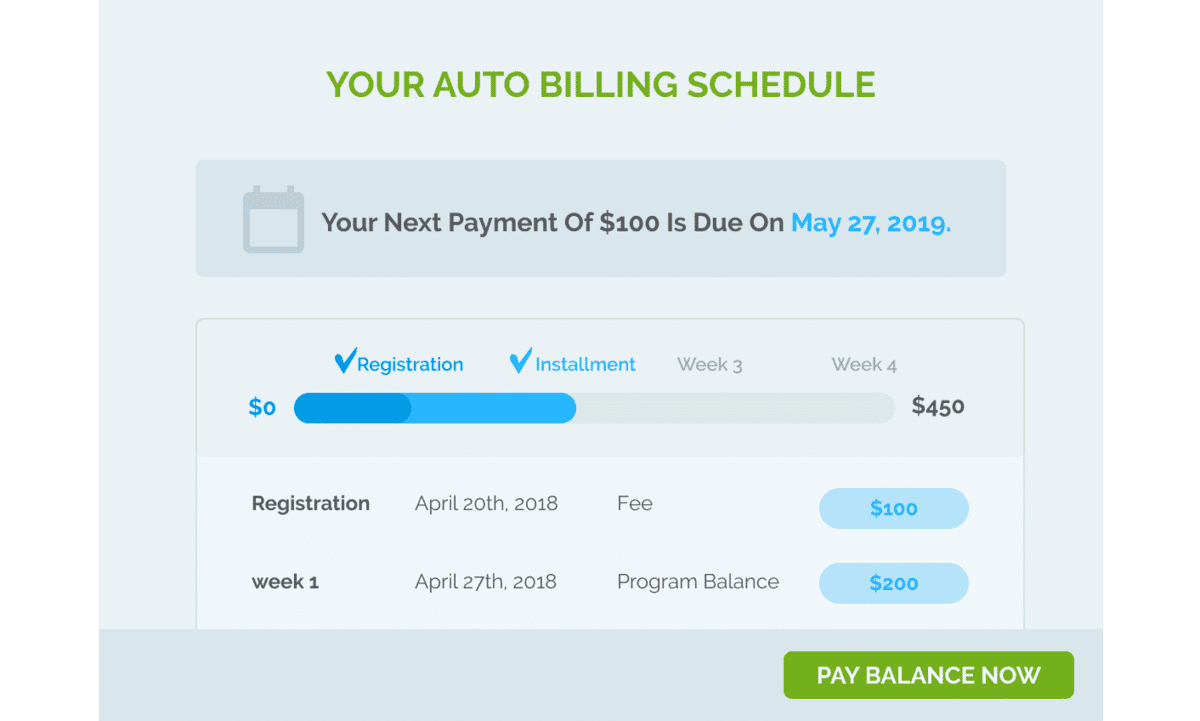
Source: Regpack
That way, students only have to submit their payment information once, and from then on, the funds will be drawn automatically from their account or card, as long as they’ve given you permission.
Some software, like Regpack, even empower you to create personalized billing plans for your students, or various payment plans to choose from, as shown below.

Source: Regpack
In this case, students can select from paying in full, paying some now and more later, and paying in monthly installments.
Customers love this option because they get to decide not only how they pay for the course, but also when they pay.
They can choose a payment plan that works with their specific budget and income.
Optimizing your course registration process through more streamlined payments is all about giving your customers flexibility and convenience when paying for your course.
Send Automated Confirmation Emails
Automated confirmation emails are a great way to ensure that your students stay informed about the progress of their registration and the next steps.
Using registration software, businesses can configure confirmation emails to send automatically whenever a student submits an online registration form.
For maximum impact, your confirmation email should include a few things.
First, it should thank the student for registering and then confirm that the registration and payment were successfully processed.
It should also go over the details of the course, such as the following:
| Course location |
| Course start date |
| Any course materials to download or buy |
| The teacher’s contact information |
| An overview of the course structure |
Many businesses also use their confirmation emails to guide students to the next steps, whether that’s saying hello in the course community or watching the first lecture.
To do this, they’ll often include a link that students can click to navigate to the beginning of the course, as Hillsdale has done below in their confirmation email:
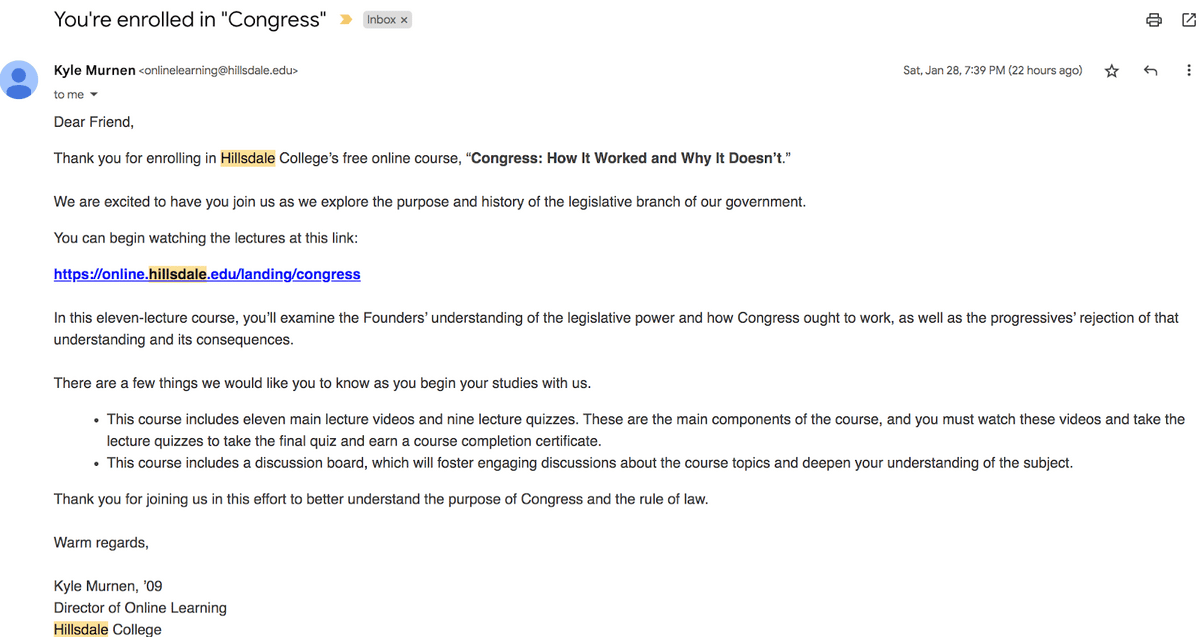
Source: Hillsdale College
This can help you improve engagement with your courses, ensuring that students don’t sign up and then forget to start taking the course.
Hillsdale’s confirmation email also highlights important features that students might’ve missed while signing up, like the fact that the course includes a discussion board where students can communicate with other students online.
Some businesses include an Action Items section in their confirmation emails, as Location Rebel does below for their online course.

Source: Location Rebel
Giving students some simple action items to take ASAP will capitalize on the excitement that naturally follows buying a new course.
If you want, you can also split your confirmation email into two emails—the first confirming the payment and the second providing a welcome message and course details.
As for how to set up these automated emails, most course registration software will include an email communication feature that allows you to set up these trigger-based automations.
The best ones will also use email templates that automatically populate with the recipient’s information, like their first name or other relevant data in your software, so that the email feels personalized and thoughtful.
Here’s one such template, albeit for a payment invoice, in Regpack registration software.

Source: Regpack
The above example goes to show that automated confirmation emails have uses that extend past the registration process.
You can also create automated emails that go out whenever an invoice is past due, for example.
In sum, automated emails optimize the course registration process by automatically and quickly delivering critical information to your students after they sign up and pay.
Using the feature helps you paint your brand as an attentive teacher, even though you won’t have to lift a finger to welcome your students.
Conclusion
Optimizing your course registration process will lead to higher conversion rates, more registrations, and increased revenue for your business.
Some easy steps you can take to start the steady march toward optimization include adding embedded registration forms to your website, offering group registration, and sending automated confirmation emails to new students.
If you want to learn more about improving registration numbers for your course, check out our ultimate guide on selling online courses, where we cover everything from how to find your target audience to how to attract them to your website.
